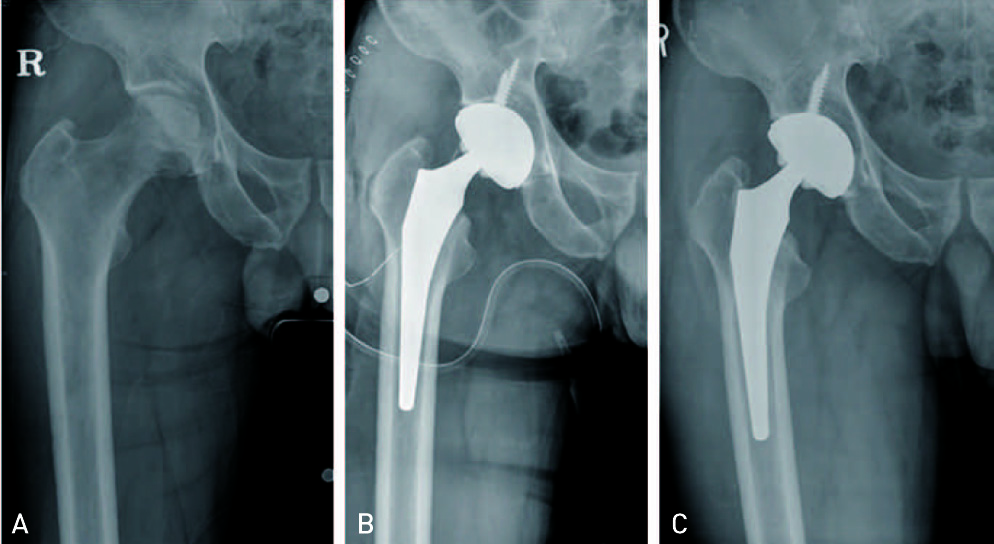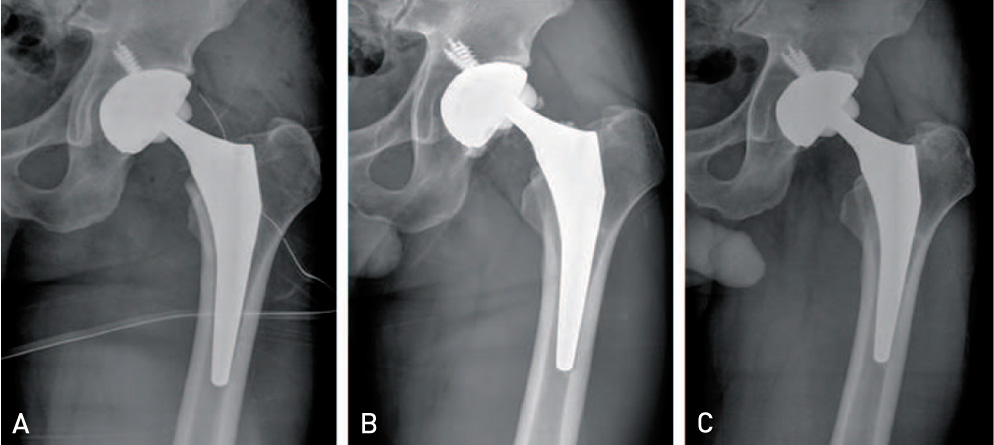Hip Pelvis.
2014 Jun;26(2):84-91. 10.5371/hp.2014.26.2.84.
Primary Total Hip Arthroplasty Using Third Generation Ceramic-Ceramic Articulation: Results after a Minimum of Three-years of Follow-up
- Affiliations
-
- 1Department of Orthopedics, Yonsei University Wonju College of Medicine, Wonju, Korea. hwtonlka@wonju.yonsei.ac.kr
- KMID: 2054169
- DOI: http://doi.org/10.5371/hp.2014.26.2.84
Abstract
- PURPOSE
This study assessed the short term clinicoradiological results of primary total hip arthroplasty using third generation ceramic-ceramic articulation Accolade TMZF femoral stems.
MATERIALS AND METHODS
Two hundred and seventy two patients (294 hips) with primary total hip arthroplasty using third generation ceramic-ceramic articulation Accolade TMZF femoral stems who had been followed-up for a minimum of 3 years were included. Clinicoradiological results were analyzed and postoperative complications were observed.
RESULTS
At final follow-up, mean Harris hip score was increased from 52 to 94 points. On radiogical evaluation, the average acetabular inclination was 42 degrees and the average acetabular anteversion was 15 degrees. Neither osteolysis nor loosening were observed around the acetabulum or proximal femur. Among 294 acetabular cups, 293 cups (99.66%) achieved stable fixation. Regarding the 294 femoral stems, 286 (97.28%) had bony fixation, 7 (2.38%) had fibrous fixation, and none were found to have unstable stem fixation. Proximal bone resorption was observed in 17 hips (5.78%; only Grade 1) and radiolucent lines were observed in 88 hips (29.93%), however, all were around the distal smooth portion of the stems. Postoperative complications included dislocation in 6 hips (2.04%), heterotopic ossification in 3 hips (1.02%), ceramic fractures in 4 hips (1.36%), superficial infection in 1 hip (0.34%), and squeaking in 8 hips (2.72%).
CONCLUSION
The short term clinicoradiological results of primary total hip arthroplasty using third generation ceramic-ceramic articulation and Accolade TMZF femoral stems together with Secur-Fit acetabular cups were satisfactory. However, problems such as ceramic fractures and squeaking after arthroplasty were observed. Additional studies are necessary in order to develop methods that may reduce or eliminate these complications.
Keyword
MeSH Terms
Figure
Reference
-
1. Barrack RL, Burak C, Skinner HB. Concerns about ceramics in THA. Clin Orthop Relat Res. 2004; 429:73–79.
Article2. Dorr LD, Wan Z, Song M, Ranawat A. Bilateral total hip arthroplasty comparing hydroxyapatite coating to porous-coated fixation. J Arthroplasty. 1998; 13:729–736.
Article3. Engh CA, Hooten JP Jr, Zettl-Schaffer KF, et al. Porous-coated total hip replacement. Clin Orthop Relat Res. 1994; 298:89–96.
Article4. Gruen TA, McNeice GM, Amstutz HC. "Modes of failure" of cemented stem-type femoral components: a radiographic analysis of loosening. Clin Orthop Relat Res. 1979; 141:17–27.5. Callaghan JJ, Dysart SH, Savory CG. The uncemented porous-coated anatomic total hip prosthesis. Two-year results of a prospective consecutive series. J Bone Joint Surg Am. 1988; 70:337–346.
Article6. Boardman DL. A simple and reliable method of estimating radiographic acetabular anteversion. In : Proceedings of the 68th Annual Meeting of the American Academy of Orthopaedic Surgeons (February 28-March 4); San Francisco, CA: American Academy of Orthopaedic Surgeons;2001. p. 497.7. DeLee JG, Charnley J. Radiological demarcation of cemented sockets in total hip replacement. Clin Orthop Relat Res. 1976; 121:20–32.
Article8. Engh CA, Massin P, Suthers KE. Roentgenographic assessment of the biologic fixation of porous-surfaced femoral components. Clin Orthop Relat Res. 1990; 257:107–128.
Article9. Brooker AF, Bowerman JW, Robinson RA, Riley LH Jr. Ectopic ossification following total hip replacement. Incidence and a method of classification. J Bone Joint Surg Am. 1973; 55:1629–1632.10. Older J. Charnley low-friction arthroplasty: a worldwide retrospective review at 15 to 20 years. J Arthroplasty. 2002; 17:675–680.11. Synder M, Drobniewski M, Kozłowski P, Grzegorzewski A. Ceramic-ceramic articulation in uncemented total hip arthroplasty. Wiad Lek. 2005; 58:193–197.12. Casper DS, Kim GK, Restrepo C, Parvizi J, Rothman RH. Primary total hip arthroplasty with an uncemented femoral component five- to nine-year results. J Arthroplasty. 2011; 26:838–841.13. Issa K, Pivec R, Wuestemann T, Tatevossian T, Nevelos J, Mont MA. Radiographic fit and fill analysis of a new second-generation proximally coated cementless stem compared to its predicate design. J Arthroplasty. 2014; 29:192–198.
Article14. McLaughlin JR, Lee KR. Total hip arthroplasty with an uncemented tapered femoral component. J Bone Joint Surg Am. 2008; 90:1290–1296.
Article15. Parvizi J, Keisu KS, Hozack WJ, Sharkey PF, Rothman RH. Primary total hip arthroplasty with an uncemented femoral component: a long-term study of the Taperloc stem. J Arthroplasty. 2004; 19:151–156.16. Woolson ST, Maloney WJ. Cementless total hip arthroplasty using a porous-coated prosthesis for bone ingrowth fixation. 3 1/2-year follow-up. J Arthroplasty. 1992; 7:Suppl. 381–388.
Article17. Hamilton WG, McAuley JP, Dennis DA, Murphy JA, Blumenfeld TJ, Politi J. THA with Delta ceramic on ceramic: results of a multicenter investigational device exemption trial. Clin Orthop Relat Res. 2010; 468:358–366.
Article18. Head WC, Mallory TH, Emerson RH Jr. The proximal porous coating alternative for primary total hip arthroplasty. Orthopedics. 1999; 22:813–815.
Article19. Heekin RD, Callaghan JJ, Hopkinson WJ, Savory CG, Xenos JS. The porous-coated anatomic total hip prosthesis, inserted without cement. Results after five to seven years in a prospective study. J Bone Joint Surg Am. 1993; 75:77–91.
Article20. Kim YH, Kim VE. Results of the Harris-Galante cementless hip prosthesis. J Bone Joint Surg Br. 1992; 74:83–87.
Article21. Archibeck MJ, Berger RA, Jacobs JJ, et al. Second-generation cementless total hip arthroplasty. Eight to eleven-year results. J Bone Joint Surg Am. 2001; 83-A:1666–1673.22. Sporer SM, Paprosky WG. Biologic fixation and bone ingrowth. Orthop Clin North Am. 2005; 36:105–111. vii
Article23. Keurentjes JC, Kuipers RM, Wever DJ, Schreurs BW. High incidence of squeaking in THAs with alumina ceramic-on-ceramic bearings. Clin Orthop Relat Res. 2008; 466:1438–1443.
Article24. Yang CC, Kim RH, Dennis DA. The squeaking hip: a cause for concern-disagrees. Orthopedics. 2007; 30:739–742.
Article25. Walter WL, Insley GM, Walter WK, Tuke MA. Edge loading in third generation alumina ceramic-on-ceramic bearings: stripe wear. J Arthroplasty. 2004; 19:402–413.26. Ranawat AS, Ranawat CS. The squeaking hip: a cause for concern-agrees. Orthopedics. 2007; 30:738. 743.
Article27. Morlock M, Nassutt R, Janssen R, Willmann G, Honl M. Mismatched wear couple zirconium oxide and aluminum oxide in total hip arthroplasty. J Arthroplasty. 2001; 16:1071–1074.
Article28. Walter WL, O'toole GC, Walter WK, Ellis A, Zicat BA. Squeaking in ceramic-on-ceramic hips: the importance of acetabular component orientation. J Arthroplasty. 2007; 22:496–503.29. Heck DA, Partridge CM, Reuben JD, Lanzer WL, Lewis CG, Keating EM. Prosthetic component failures in hip arthroplasty surgery. J Arthroplasty. 1995; 10:575–580.
Article30. Yamaguchi M, Akisue T, Bauer TW, Hashimoto Y. The spatial location of impingement in total hip arthroplasty. J Arthroplasty. 2000; 15:305–313.
Article31. Maccauro G, Piconi C, Burger W, et al. Fracture of a Y-TZP ceramic femoral head. Analysis of a fault. J Bone Joint Surg Br. 2004; 86:1192–1196.32. Masonis JL, Bourne RB, Ries MD, McCalden RW, Salehi A, Kelman DC. Zirconia femoral head fractures: a clinical and retrieval analysis. J Arthroplasty. 2004; 19:898–905.33. Koo KH, Ha YC, Jung WH, Kim SR, Yoo JJ, Kim HJ. Isolated fracture of the ceramic head after third-generation alumina-on-alumina total hip arthroplasty. J Bone Joint Surg Am. 2008; 90:329–336.
Article34. Min BW, Song KS, Kang CH, Bae KC, Won YY, Lee KY. Delayed fracture of a ceramic insert with modern ceramic total hip replacement. J Arthroplasty. 2007; 22:136–139.
Article35. Toni A, Traina F, Stea S, et al. Early diagnosis of ceramic liner fracture. Guidelines based on a twelve-year clinical experience. J Bone Joint Surg Am. 2006; 88:Suppl 4. 55–63.
- Full Text Links
- Actions
-
Cited
- CITED
-
- Close
- Share
- Similar articles
-
- Short-term Results of Cementless Ceramic-on-ceramic Articulation Total Hip Arthroplasty
- Cementless Total Hip Arthroplasty with Fourth Generation Ceramic-on-Ceramic Articulation: Minimum Two Years of Follow-up
- Cementless Revision Total Hip Arthroplasty with Ceramic Articulation
- Short-term Results of Cementless Total Hip Arthroplasty Using Ceramic on Ceramic Articulation
- Total Hip Arthroplasty with Ceramic-on-Ceramic Articulation: Minimum 5-year Follow-up Results



